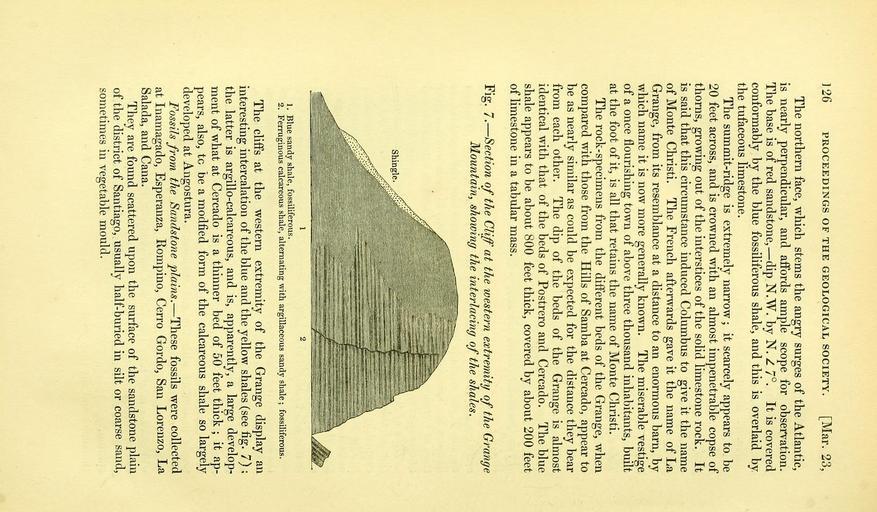MAKE A MEME
View Large Image

| View Original: | The_Quarterly_journal_of_the_Geological_Society_of_London_(12511844445).jpg (3200x1869) | |||
| Download: | Original | Medium | Small | Thumb |
| Courtesy of: | commons.wikimedia.org | More Like This | ||
| Keywords: The Quarterly journal of the Geological Society of London (12511844445).jpg 26 PROCEEDINGS OF THE GEOLOGICAL SOCIETY Mar 23 <br> The northern face which stems the angry surges of the Atlantic <br> is nearly perpendicular and affords ample scope for observation <br> The base is of red sandstone ” dip N W by N Z 7° It is covered <br> conformably by the blue fossiliferous shale and this is overlaid by <br> the tufaceous limestone <br> The summit-ridge is extremely narrow ; it scarcely appears to be <br> 20 feet across and is crowned with an almost impenetrable copse of <br> thorns growing out of the interstices of the solid limestone rock It <br> is said that this circumstance induced Columbus to give it the name <br> of Monte Christi The French afterwards gave it the name of La <br> Grange from its resemblance at a distance to an enormous barn by <br> which name it is now more generally known The miserable vestige <br> of a once flourishing town of above three thousand inhabitants built <br> at the foot of it is all that retains the name of Monte Christi <br> The rock- specimens from the different beds of the Grange when <br> compared with those from the Hills of Samba at Cercado appear to <br> be as nearly similar as could be expected for the distance they bear <br> from each other The dip of the beds of the Grange is almost <br> identical with that of the beds of Postrero and Cercado The blue <br> shale appears to be about 800 feet thick covered by about 200 feet <br> of limestone in a tabular mass <br> Fig 7 ” Section of the Cliff at the western extremity of the Grange <br> Mountain showing the interlacing of the shales <br> 1 <br> 1 Blue sandy shale fossiliferous <br> 2 Ferruginous calcareous shale alternating with argillaceous sandy shale ; fossiliferous <br> The cliffs at the western extremity of the Grange display an <br> interesting intercalation of the blue and the yellow shales see fig 7 ; <br> the latter is argillo-calcareous and is apparently a large develop- <br> ment of what at Cercado is a thinner bed of 50 feet thick ; it ap- <br> pears also to be a modfied form of the calcareous shale so largely <br> developed at Angostura <br> Fossils from the Sandstone plains ” These fossils were collected <br> at Inamagado Esperanza Rompino Cerro Gordo San Lorenzo La <br> Salada and Cana <br> They are found scattered upon the surface of the sandstone plain <br> of the district of Santiago usually half-buried in silt or coarse sand <br> sometimes in vegetable mould 34983229 108767 51125 Page 126 Text v 9 http //www biodiversitylibrary org/page/34983229 1853 Geological Society of London NameFound Ferruginous Biodiversity Heritage Library The Quarterly journal of the Geological Society of London v 9 1853 Geology Periodicals Smithsonian Libraries bhl page 34983229 dc identifier http //biodiversitylibrary org/page/34983229 smithsonian libraries Information field Flickr posted date ISOdate 2014-02-14 Check categories 2015 August 26 CC-BY-2 0 BioDivLibrary https //flickr com/photos/61021753 N02/12511844445 2015-08-27 09 53 48 cc-by-2 0 PD-old-70-1923 The Quarterly journal of the Geological Society of London 1853 Photos uploaded from Flickr by Fæ using a script | ||||